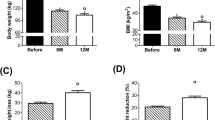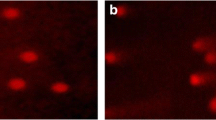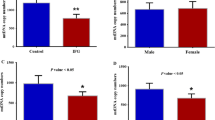Abstract
The purpose of this study was to investigate the effect of body mass index on DNA damage of lymphocytes in obese patients without carbohydrate metabolism disorder in the Kazakh population. Research design is based on a single-stage descriptive study. The sample included 239 patients aged 18–60 years. Among the participants, people with chronic decompensated diseases, with bad habits (smokers, drug users, drinkers) were excluded. Special attention was paid to the exclusion of diabetes mellitus to exclude the effect of hyperglycemia on DNA damage when forming the sample according to WHO criteria. The following were estimated: the diameter of the breaks (Foci dia, µm), the average number of γ-H2AX (n) foci detected per cell. The study of DNA damage of blood lymphocytes in individuals of the Kazakh population showed high rates of DSB with a BMI over 40 kg/m2. The number of breaks per cell in women is significantly higher than in men (p = 0.004). The median test revealed a significant difference in the number of DSBs between different age groups (χ2 = 10.39, p = 0.0155). Obesity is now gaining momentum, so the study of the effect of body mass index on lymphocyte DNA damage in obese patients without impaired carbohydrate metabolism gives valuable results in the treatment of this disease.




Similar content being viewed by others
Data availability
The data that support the findings of this study are available on request from the corresponding author.
Change history
13 September 2023
This article has been retracted. Please see the Retraction Notice for more detail: https://doi.org/10.1007/s11010-023-04852-7
References
Ortega FB, Lavie CJ, Blair SN (2016) Obesity and cardiovascular disease. Circ Res 118(11):1752–1770. https://doi.org/10.1161/circresaha.115.306883
Merder-Coşkun D, Uzuner A, Keniş-Coşkun Ö, Çelenlioğlu AE, Akman M, Karadağ-Saygı E (2017) Relationship between obesity and musculoskeletal system findings among children and adolescents. Turk J Phys Med Rehab 63(3):207–214. https://doi.org/10.5606/tftrd.2017.422
Lennon H, Sperrin M, Badrick E, Renehan AG (2016) The obesity paradox in cancer. Curr Oncol Rep 18(9):56. https://doi.org/10.1007/s11912-016-0539-4
Apovian CM (2016) Obesity: definition, comorbidities, causes, and burden. Am J Manag Care 22:176–185
Li G, Zhang H, Cao K, Zhai Zh, Wang Zh, Yang L, Han J (2022) Transcriptome of visceral adipose tissue identifies an inflammation-related ceRNA network that regulates obesity. Mol Cell Biochem. https://doi.org/10.1007/s11010-022-04362-y
Hanafi MY, Saleh MM, Saad MI, Abdelkhalek TM, Kamel MA (2016) Transgenerational effects of obesity and malnourishment on diabetes risk in F2 generation. Mol Cell Biochem 412:269–280. https://doi.org/10.1007/s11010-015-2633-6
Jang Y (2003) Visceral fat accumulation determines postprandial lipemic response, lipid peroxidation, DNA damage, and endothelial dysfunction in nonobese Korean men. J Lip Res 44(12):2356–2364. https://doi.org/10.1194/jlr.M300233-JLR200
Tomasello B (2011) DNA damage in normal-weight obese syndrome measured by Comet assay. Mediterr J Nutr Met 4(2):99–104. https://doi.org/10.1007/s12349-010-0035-6
Torres-Bugarin O (2009) Genetic profile of overweight and obese school-age children. Tox Environ Chem 91(4):789–795. https://doi.org/10.1080/02772240802404966
Binici DN, Karaman A, Coşkun M, Oğlu AU, Uçar F (2013) Genomic damage in patients with type-2 diabetes mellitus. Genet Couns 24(2):149–156
Lodovici M, Giovannelli L, Pitozzi V, Bigagli E, Bardini G, Rotella CM (2008) Oxidative DNA damage and plasma antioxidant capacity in type 2 diabetic patients with good and poor glycaemic control. Mutat Res 638(1–2):98–102. https://doi.org/10.1016/j.mrfmmm.2007.09.002
Runge R, Hiemann R, Wendisch M, Kasten-Pisula U, Storch K, Zöphel K, Fritz C, Roggenbuck D, Wunderlich G, Conrad K, Kotzerke J (2012) Fully automated interpretation of ionizing radiation-induced γH2AX foci by the novel pattern recognition system AKLIDES®. Intern J Radiat Biol 88(5):439–447. https://doi.org/10.3109/09553002.2012.658468
Azzarà A, Pirillo C, Giovannini C, Federico G, Scarpato R (2016) Different repair kinetic of DSBs induced by mitomycin C in peripheral lymphocytes of obese and normal weight adolescents. Mutat Res 789:9–14
Abdul Hamid Z, Mohd Zulkifly MF, Hamid A, Lubis SH, Mohammad N, Ishak I, Mohd Saat NZ, Othman HF, Ghazali AR, Mohd Rafaai MJ, Mohd Noor MR, Rajab NF (2016) The association of nuclear abnormalities in exfoliated buccal epithelial cells with the health status of different agricultural activities farmers in Peninsular Malaysia. Genes Environ 38:7. https://doi.org/10.1186/s41021-016-0032-1
Liu AL, Lu WQ, Wang ZZ, Chen WH, Lu WH, Yuan J, Nan PH, Sun JY, Zou YL, Zhou LH, Zhang C, Wu TC (2006) Elevated levels of urinary 8-hydroxy-2-deoxyguanosine, lymphocytic micronuclei, and serum glutathione S-transferase in workers exposed to coke oven emissions. Environ Health Perspect 114(5):673–677. https://doi.org/10.1093/carcin/bgp278
Graille M, Wild P, Sauvain JJ, Hemmendinger M, Guseva Canu I, Hopf NB (2020) Urinary 8-OHdG as a biomarker for oxidative stress: a systematic literature review and meta-analysis. Int J Mol Sci 21(11):3743. https://doi.org/10.3390/ijms21113743
Karbownik-Lewinska M, Szosland J, Kokoszko-Bilska A, Stępniak J, Zasada K, Gesing A, Lewinski A (2012) Direct contribution of obesity to oxidative damage to macromolecules. Neuro Endocrinol Lett 33(4):453–461
Giovannini C, Piaggi S, Federico G, Scarpato R (2014) High levels of γ-H2AX foci and cell membrane oxidation in adolescents with type 1 diabetes. Mutat Res 770:128–135. https://doi.org/10.1016/j.mrfmmm.2014.08.005
Tornovsky-Babeay S, Dadon D, Ziv O, Tzipilevich E, Kadosh T, Schyr-Ben Haroush R, Hija A, Stolovich-Rain M, Furth-Lavi J, Granot Z, Porat S, Philipson LH, Herold KC, Bhatti TR, Stanley C, Ashcroft FM, In’t Veld P, Saada A, Magnuson MA, Glaser B, Dor Y (2014) Type 2 diabetes and congenital hyperinsulinism cause DNA double-strand breaks and p53 activity in β cells. Cell Metab 19(1):109–121. https://doi.org/10.1016/j.cmet.2013.11.007
Lippi G, Tarperi C, Danese E, Montagnana M, Festa L, Benati M, Salvagno GL, Bonaguri Ch, Bacchi E, Donà S, Roggenbuck D, Moghetti P, Schena F (2018) Middle-distance running and DNA damage in diabetics. J Lab Prec Med. https://doi.org/10.21037/jlpm.2018.02.02
Dobrzynska MM, Pachocki KA, Owczarska K (2018) DNA strand breaks in peripheral blood leucocytes of Polish blood donors. Mutagen 33(1):69–76. https://doi.org/10.1093/mutage/gex024
Løhr M, Jensen A, Eriksen L, Grønbæk M, Loft S, Møller P (2015) Age and metabolic risk factors associated with oxidatively damaged DNA in human peripheral blood mononuclear cells. Oncotarget 6(5):2641–2653. https://doi.org/10.18632/oncotarget.3202
Møller P (2019) Effect of age and sex on the level of DNA strand breaks and oxidatively damaged DNA in human blood cells. Mut Res Gen Toxic Environ Mut 838:16–21. https://doi.org/10.1016/j.mrgentox.2018.11.010
Mah LJ, El-Osta A, Karagiannis TC (2010) GammaH2AX as a molecular marker of aging and disease. Epigenetics 5(2):129–136. https://doi.org/10.4161/epi.5.2.11080
Mamenko O, Portiannyk S (2021) Rank non-parametric correlation analysis of indicators of heavy metal transition from blood to cow's milk to assess its environmental safety. Scient Horizons 24(5):35-45
Funding
The authors have not disclosed any funding.
Author information
Authors and Affiliations
Corresponding author
Ethics declarations
Conflict of interest
All authors state they have no conflicts of interest.
Ethical approval
Not applicable.
Consent to participate
Not applicable.
Consent for publication
Not applicable.
Additional information
Publisher's Note
Springer Nature remains neutral with regard to jurisdictional claims in published maps and institutional affiliations.
This article has been retracted. Please see the retraction notice for more detail:https://doi.org/10.1007/s11010-023-04852-7
Rights and permissions
Springer Nature or its licensor (e.g. a society or other partner) holds exclusive rights to this article under a publishing agreement with the author(s) or other rightsholder(s); author self-archiving of the accepted manuscript version of this article is solely governed by the terms of such publishing agreement and applicable law.
About this article
Cite this article
Kudabayeva, K., Bazargaliyev, Y. & Kosmuratova, R. RETRACTED ARTICLE: The relationship of double-stranded DNA breaks in blood lymphocytes and obesity without carbohydrate metabolism disorder. Mol Cell Biochem 477, 2249–2255 (2022). https://doi.org/10.1007/s11010-022-04440-1
Received:
Accepted:
Published:
Issue Date:
DOI: https://doi.org/10.1007/s11010-022-04440-1




